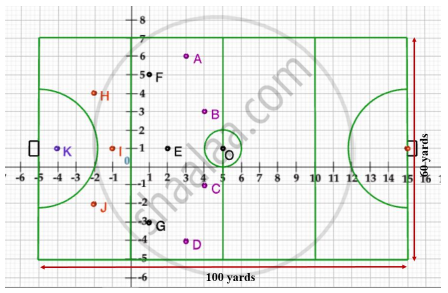Advertisements
Advertisements
प्रश्न
The point A(2, 7) lies on the perpendicular bisector of line segment joining the points P(6, 5) and Q(0, – 4).
विकल्प
True
False
उत्तर १
This statement is False.
Explanation:
If A(2, 7) lies on perpendicular bisector of P(6, 5) and Q(0, – 4),
Then AP = AQ
∴ AP = `sqrt((6 - 2)^2 + (5 - 7)^2`
= `sqrt((4)^2 + (-2)^2`
= `sqrt(16 + 4)`
= `sqrt(20)`
And A = `sqrt((0 - 2)^2 + (-4 - 7)^2`
= `sqrt((-2)^2 + (-11)^2`
= `sqrt(4 + 121)`
= `sqrt(125)`
So, A does not lies on the perpendicular bisector of PQ.
उत्तर २
This statement is False.
Explanation:
If the point A(2, 7) lies on the perpendicular bisector of the line segment, then the point A satisfy the equation of perpendicular bisector.
Now, we find the equation of perpendicular bisector.
For this, we find the slope of perpendicular bisector.
∴ Slope of perpendicular bisector = `(-1)/("Slope of line segment joining the points" (5, -3) "and" (0, -4))`
= `(-1)/((-4 - (-3))/(0 - 5))` ...`[∵ "Slope" = (y_2 - y_1)/(x_2 - x_1)]`
= 5
[Since, perpendicular bisector is perpendicular to the line segment, so its slopes have the condition, m1 · m2 = – 1]
Since, the perpendicular bisector passes through the mid-point of the line segment joining the points (5, – 3) and (0, – 4).
∴ Mid-point of PQ = `((5 + 0)/2, (-3 - 4)/2) = (5/2, (-7)/2)`
So, the equation of perpendicular bisector having slope `1/3` and passes through the mid-point `(5/2, (-7)/2)` is
`(y + 7/2) = 5(x - 5/2)` ...[∵ Equation of line is (y – y1) = m(x – x1)]
⇒ 2y + 7 = 10x – 25
⇒ 10x – 2y – 32 = 0
⇒ 10x – 2y = 32
⇒ 5x – y = 16 ...(i)
Now, check whether the point A(2, 7) lie on the equation (i) or not
5 × 2 – 7
= 10 – 7
= 3 ≠ 16
Hence, the point A(2, 7) does not lie on the perpendicular bisector of the line segment.
APPEARS IN
संबंधित प्रश्न
Find the distance between the points (0, 0) and (36, 15). Can you now find the distance between the two towns A and B discussed in Section 7.2.
An equilateral triangle has two vertices at the points (3, 4) and (−2, 3), find the coordinates of the third vertex.
Find the distances between the following point.
P(–6, –3), Q(–1, 9)
A line segment of length 10 units has one end at A (-4 , 3). If the ordinate of te othyer end B is 9 , find the abscissa of this end.
Prove that the points (4 , 6) , (- 1 , 5) , (- 2, 0) and (3 , 1) are the vertices of a rhombus.
Calculate the distance between A (5, -3) and B on the y-axis whose ordinate is 9.
Show that the point (0, 9) is equidistant from the points (– 4, 1) and (4, 1)
Case Study -2
A hockey field is the playing surface for the game of hockey. Historically, the game was played on natural turf (grass) but nowadays it is predominantly played on an artificial turf.
It is rectangular in shape - 100 yards by 60 yards. Goals consist of two upright posts placed equidistant from the centre of the backline, joined at the top by a horizontal crossbar. The inner edges of the posts must be 3.66 metres (4 yards) apart, and the lower edge of the crossbar must be 2.14 metres (7 feet) above the ground.
Each team plays with 11 players on the field during the game including the goalie. Positions you might play include -
- Forward: As shown by players A, B, C and D.
- Midfielders: As shown by players E, F and G.
- Fullbacks: As shown by players H, I and J.
- Goalie: As shown by player K.
Using the picture of a hockey field below, answer the questions that follow:

If a player P needs to be at equal distances from A and G, such that A, P and G are in straight line, then position of P will be given by ______.
What type of a quadrilateral do the points A(2, –2), B(7, 3), C(11, –1) and D(6, –6) taken in that order, form?
What is the distance of the point (– 5, 4) from the origin?
